Attached files
| file | filename |
|---|---|
| 8-K - FORM 8-K - Paratek Pharmaceuticals, Inc. | d233658d8k.htm |
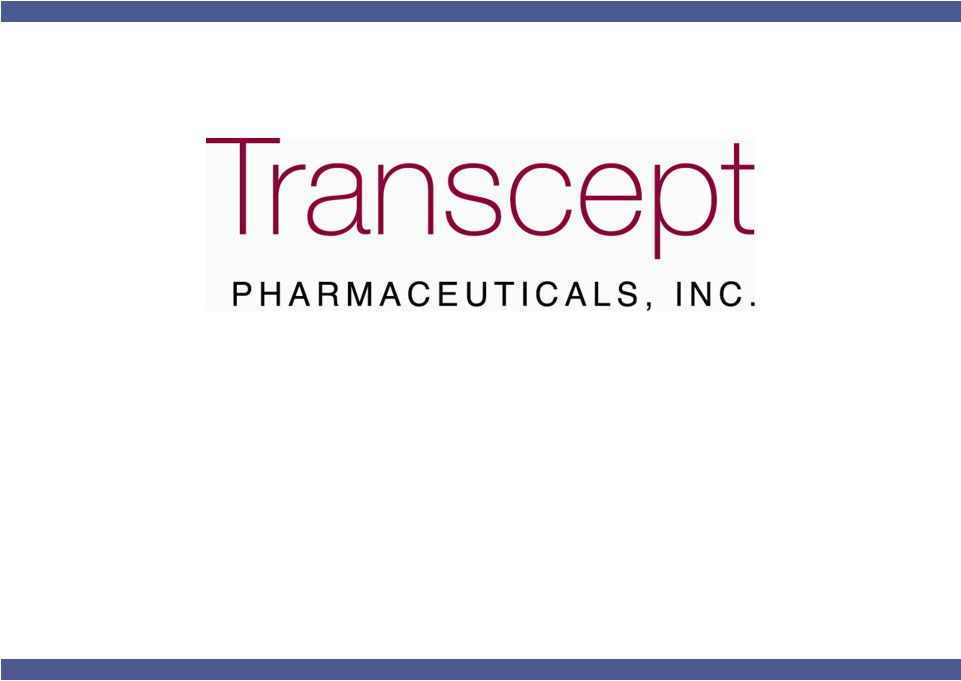 September 2011
September 2011
A specialty pharmaceutical company focused on the development
and commercialization of proprietary products to address important
therapeutic needs in the field of neuroscience
Exhibit 99.1 |
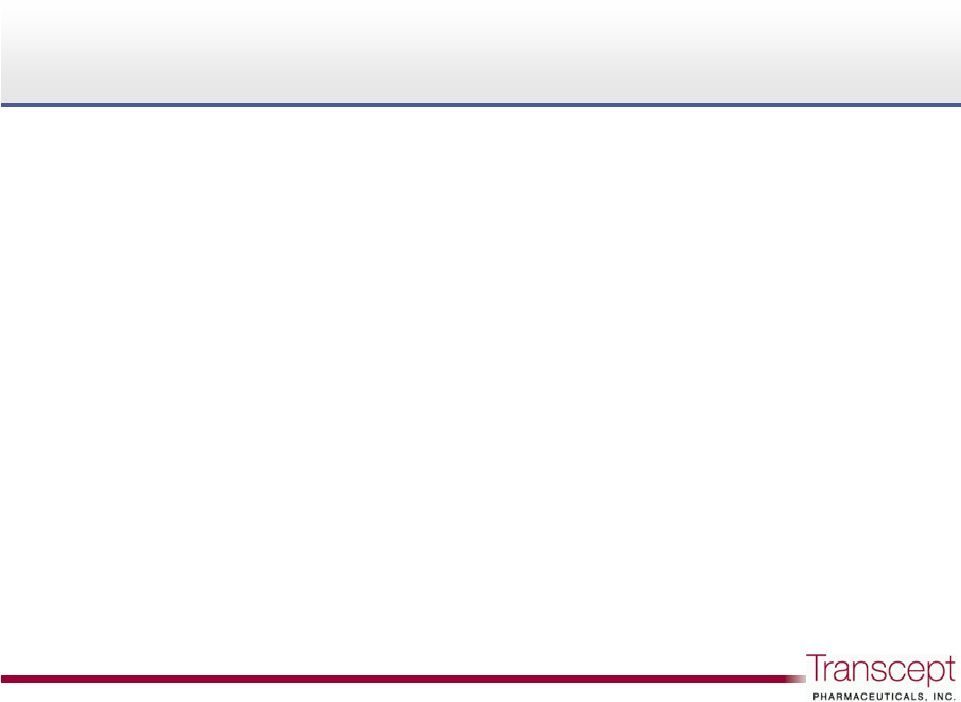 Forward
looking statements Forward looking statements
This presentation contains forward-looking statements that involve substantial risks and
uncertainties. All statements, other than statements of historical facts, included in
this presentation are forward-looking statements. Examples of such statements
include our expectation regarding the planned timing for filing and
FDA
review
of
the
Intermezzo
®
NDA;
the
sufficiency
of
the
Intermezzo
®
NDA
to
gain
FDA
approval;
that
Intermezzo
®
will
become
the
first
prescription
sleep
aid
indicated
for
use
in
the
middle
of
the
night;
the
potential
market
size
for
a
middle
of
the
night
sleep
aid;
plans
to
commercialize
Intermezzo
®
through
the Purdue collaboration and the receipt by Transcept of payments from Purdue thereunder;
reimbursement coverage for Transcept product candidates; intellectual property
protection being obtained and maintained for Transcept product candidates; and
enrollment plans for the Phase 2 study of TO-2061 and
plans to report results therefrom in late 2012. Transcept may not actually meet these expectations
and carryout
these
plans.
Various
important
factors
that
could
cause
actual
events
to
differ materially
from such
forward-looking
statements
include
FDA
deemed
insufficiencies
in
our
Intermezzo
®
NDA
resubmission,
competitive
product
commercialization;
adverse
patent
decisions
at
the
USPTO
or
in
court;
the
willingness
of
Purdue
to
commercialize
Intermezzo
®
and
its
ability
to
do
so
successfully;
payer
opinion
of
Intermezzo
®
,
if
approved;
dependence
on
third
parties
to
manufacture,
and
carry-out
the
planned study of
TO-2061, and variability in the business of Transcept generally. These and other risks
are
described
in
greater
detail
in
the
"Risk
Factors"
section
of
Transcept
periodic
reports
filed
with
the
Securities and Exchange Commission. Forward-looking statements do not reflect the
potential impact of any future in-licensing, collaborations, acquisitions,
mergers, dispositions, joint ventures, or investments Transcept may enter into or
make. Transcept does not assume any obligation to update any forward- looking
statements, except as may be required by law. 2 |
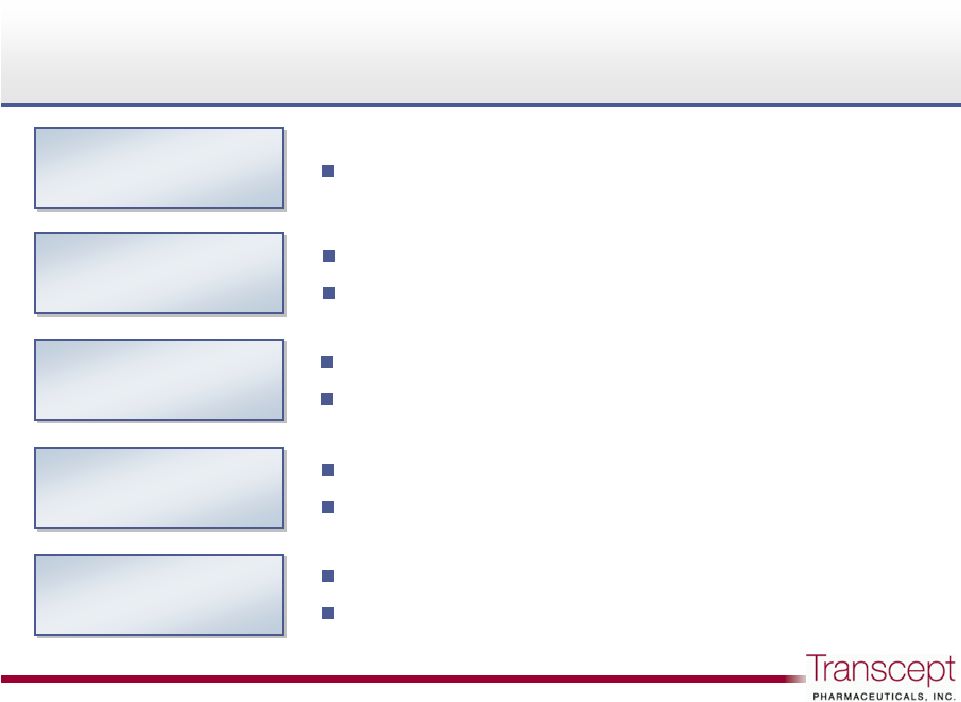 U.S.
primary care partnership: Purdue Pharma Co-promote
option
1
yr
post
Intermezzo
®
launch
6/30/11: ~$60M cash, equivalents & investments
No debt
Neuroscience / psychiatry
Intermezzo
®
: middle of the night awakenings
TO-2061
treatment
resistant
OCD
Transcept:
preparing
for
Intermezzo
®
commercialization
Transcept:
preparing
for
Intermezzo
®
commercialization
3
Intermezzo
®
NDA
resubmission:
est.
Sept
2011
TO-2061
Phase
2
results:
est.
late
2012
Therapeutic focus
Large markets,
unmet needs
Commercial
platform
Strong balance
sheet
Near term
catalysts
: |
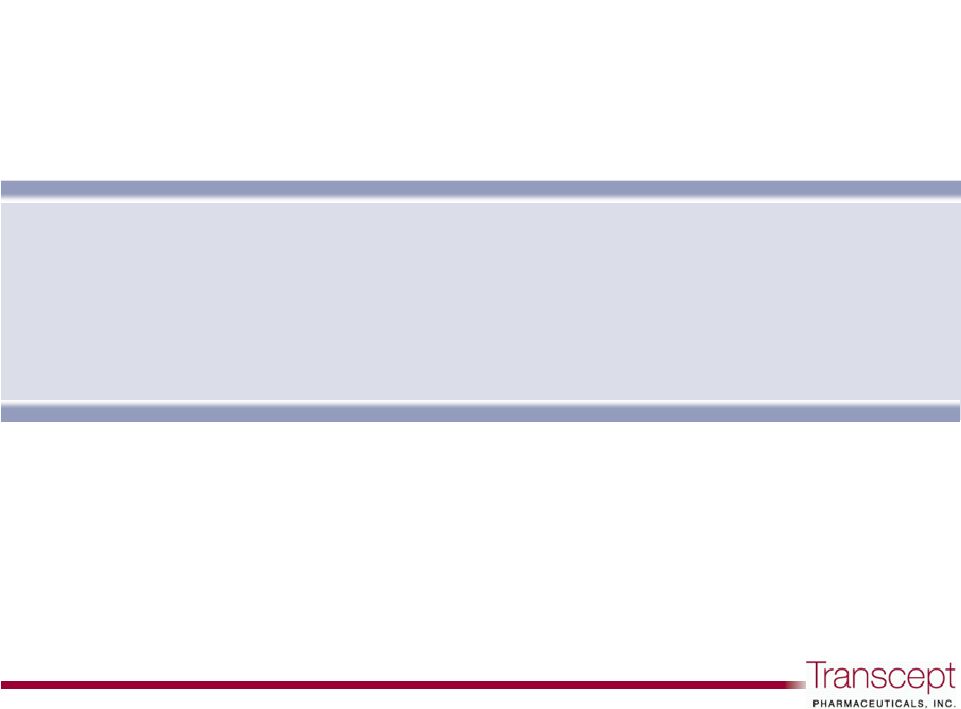 Intermezzo
®
(zolpidem tartrate sublingual tablet)
Intermezzo
®
(zolpidem tartrate sublingual tablet)
Proposed indication statement: Intermezzo
®
is indicated
for use as needed for the treatment of insomnia when a
middle of the night awakening is followed by
difficulty returning to sleep
4 |
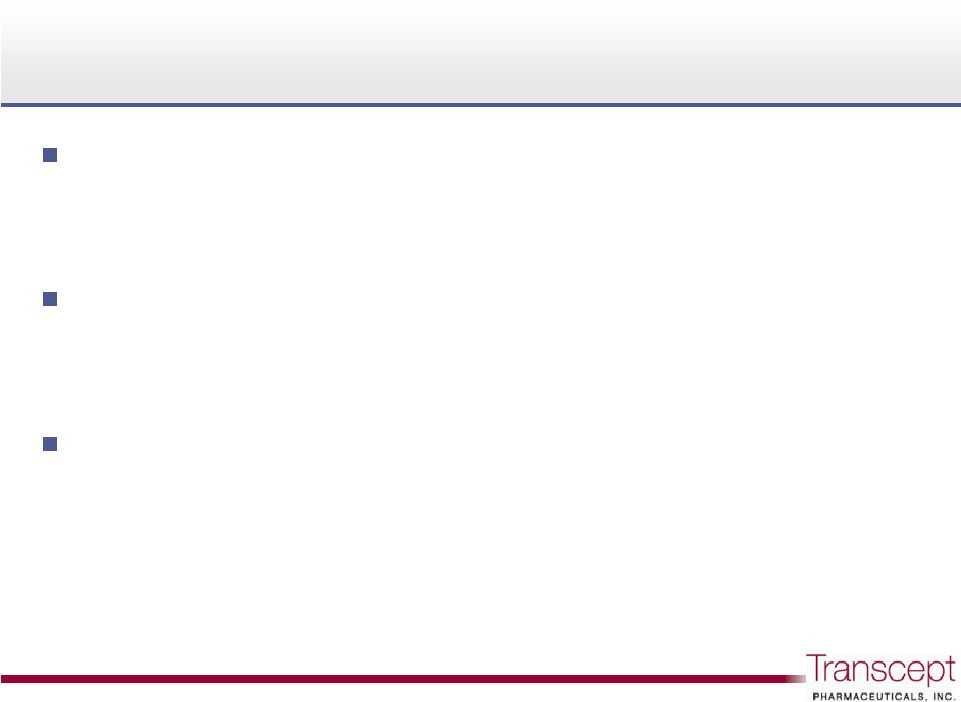 Middle of the
night (MOTN) awakening: a major unmet medical need in the insomnia category
Middle of the night (MOTN) awakening:
a major unmet medical need in the insomnia category
Large U.S. insomnia market
–
$2.1
billion
(ex-factory)
(1)
–
78
million
new
and
refill
prescriptions
(2)
Insomnia is an under-treated condition
–
11
million
patients
receive
Rx
(3)
–
4x
to
6x
more
are
not
diagnosed
or
treated
by
a
physician
(3)(4)
MOTN
awakening:
the
most
prevalent
insomnia
symptom
(5)
–
35%
of
Americans
suffer
from
MOTN
awakenings
at
least
3x
/
week
(5)
–
>90% report awakenings persist more than six months;
50%
report
awakenings
persist
more
than
five
years
(6)
5
(1)
IMS
NSP
2009;
(2)
Wolters
Kluwer,
PHAST
2010;
(3)
BluePrint
Research
Group;
(4)
Institutes
of
Medicine
-
Sleep
disorders
and
sleep deprivation
Apr. 2006; (5) Ohayon, Nocturnal awakenings and comorbid disorders in the American general
population. J of Psych Research (2009); (6) Ohayon, Difficulty in resuming or
inability to resume sleep and the links to daytime impairment, J of Psych Research (2009). |
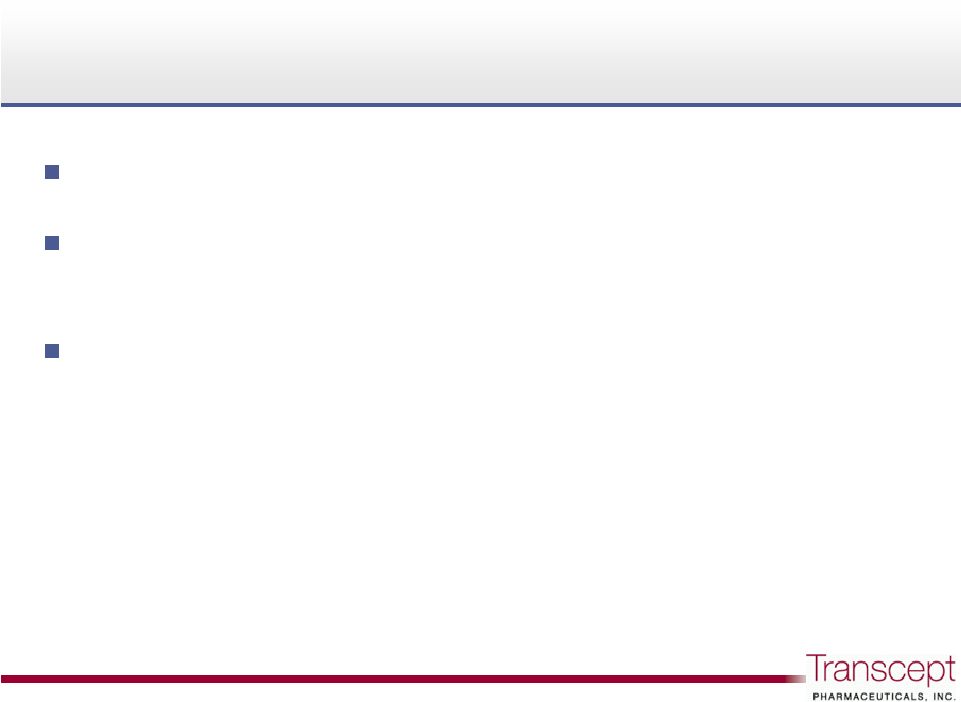 No product
currently indicated for prn treatment at the
time of a middle of the night awakening
No product currently indicated for prn
treatment at the
time of a middle of the night awakening
MOTN awakenings typically do not occur every night
7-8 hr sleep aids (Ambien
®
, Ambien CR
®
, Lunesta
®
) require
bedtime prophylactic dosing to prevent awakenings
An ideal therapeutic would:
–
Be used only at the time patients need help returning to sleep,
not every night in advance of a problem that may not occur
–
Return patients to sleep rapidly
–
Use a low dose to avoid next day residual effects
6 |
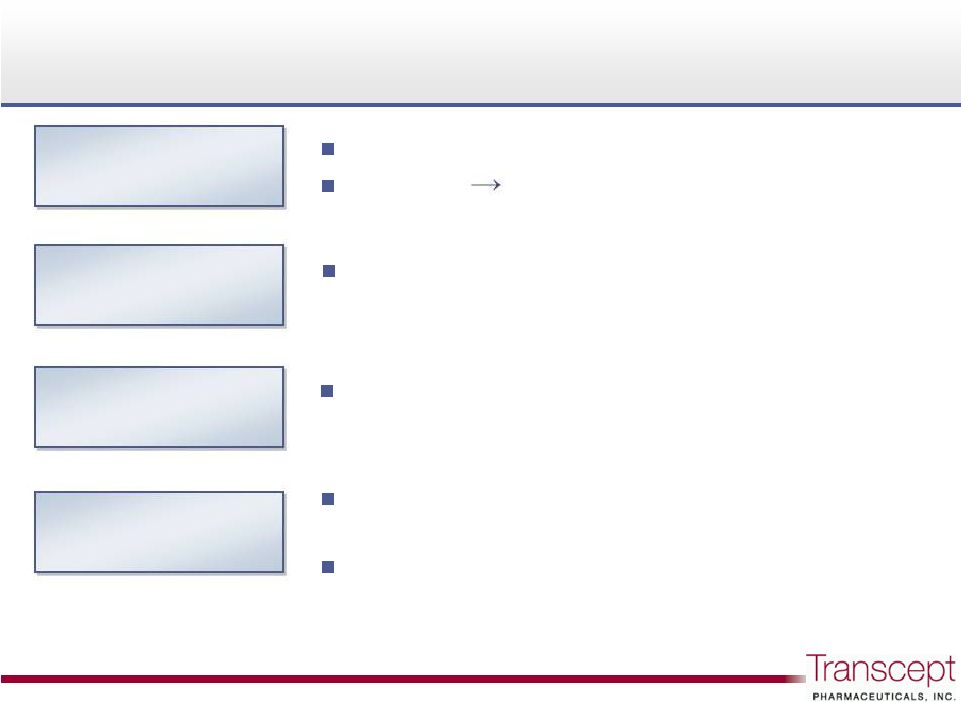 Sleep lab:
sleep onset, least squares mean men 13 min, 3.5 mg; women 16 min, 1.75 mg
No residual next-morning effects vs. placebo in
sleep lab and outpatient studies
Driving study primary statistical analysis: no
significant next morning effect vs. placebo 4 hrs
after dosing, consistent with proposed label
Sublingual tablet dissolves in ~ 2 minutes
pH drives
zolpidem base, rapidly absorbed
72% -
86% lower dose than comparable
Ambien CR
®
dose
Intermezzo
®
: anticipated to be the first sleep aid for
use in the middle of the night at the time of awakening
Intermezzo
®
: anticipated to be the first sleep aid for
use in the middle of the night at the time of awakening
7
Low dose
Novel formulation
Fast acting
Favorable 4 hr
residual effects |
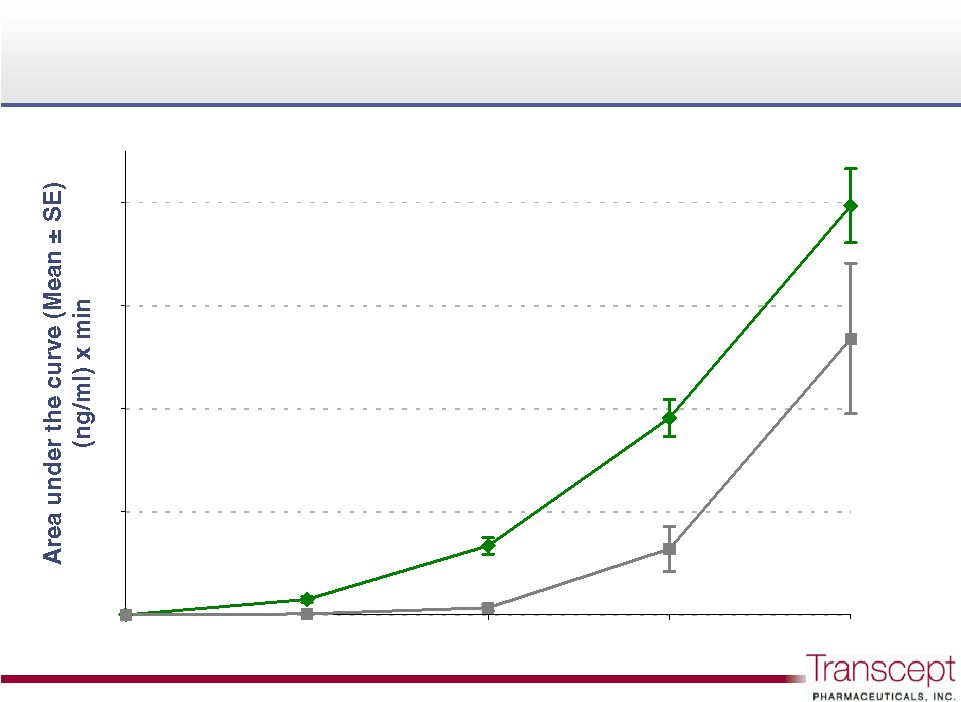 Intermezzo
®
3.5 mg delivered
more zolpidem earlier than a ~3x
higher
Ambien
®
dose
Intermezzo
®
3.5 mg delivered
more zolpidem earlier than a ~3x
higher
Ambien
®
dose
PK comparison study: Intermezzo
®
3.5mg vs. Ambien 10mg PO (n=33)
Time (min)
9.6x
3.0x
1.5x
Intermezzo
®
3.5 mg
0
1
2
3
4
0
5
10
15
20
Ambien
®
10 mg
8 |
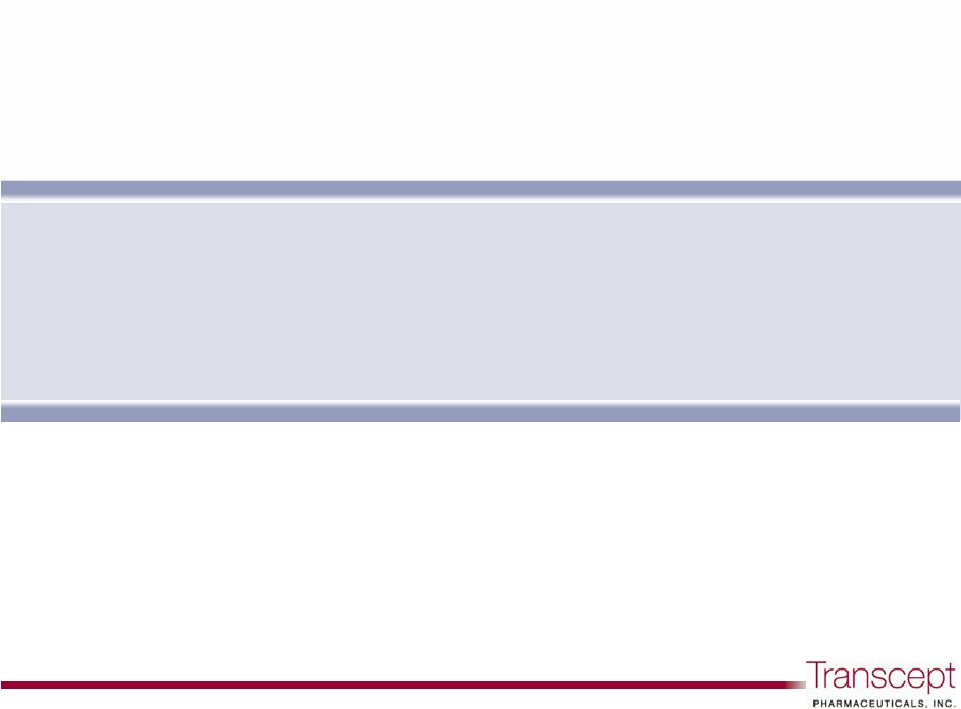 Intermezzo
®
commercial opportunity
Intermezzo
®
commercial opportunity |
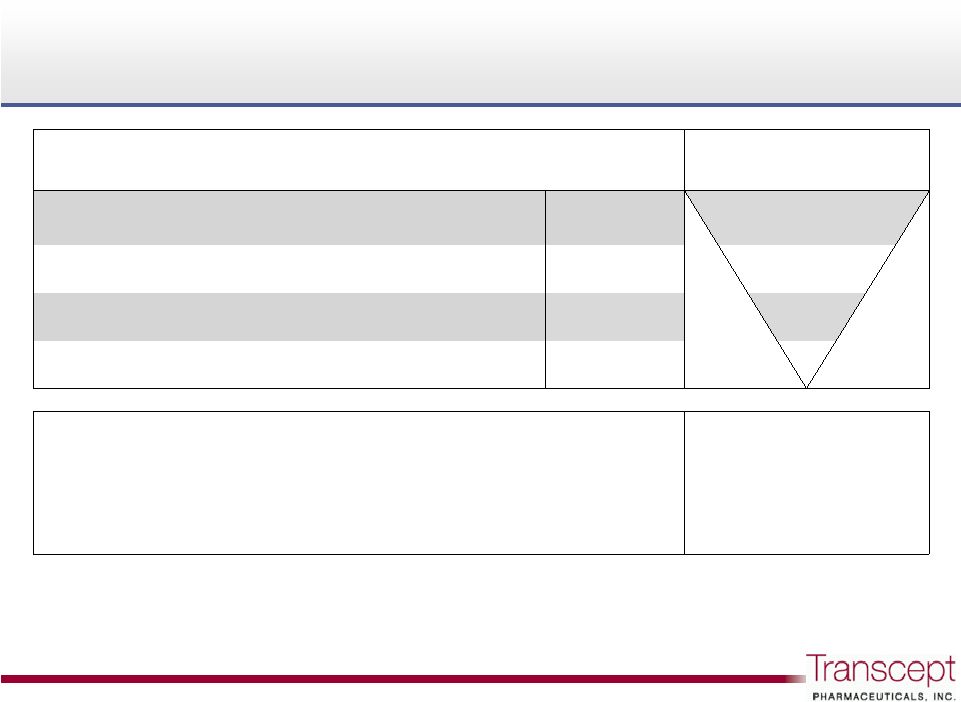 Estimating
the MOTN market size at branded prices Estimating the MOTN market size at branded
prices Ohayon, et al., Nocturnal Awakenings in the American
General Population: Prevalence and Consequences
235 M U.S. adults
(3)
x Ohayon
MOTN sufferers at least 3x week
35.5%
(1)
=
83 million
…with difficulty returning to sleep
43.0%
(1)
=
36
…without difficulty initiating sleep
62.6%
(1)
=
22
…who seek MD treatment
16.0%
(2)
=
x mean length of therapy, currently marketed Rx sleep aids
108 to 169 days
(4)
x per tablet branded pricing, currently marketed Rx sleep aids
$5.05 to $5.67
(5)
= 100% market estimate: treatment seeking MOTN patients
$1.9 B to $3.4 B
3.6
10
(1)
Ohayon,
et
al.,
Nocturnal
awakenings
in
the
American
general
population:
Prevalence
and
consequences.
World
Sleep
Conference
2007;
(2)
Estimated
based
on
percentage
applied
to
adults
with
difficulty
returning
to
sleep,
with
and
without
difficulty
initiating
sleep
in
Ohayon,
et
al.,
Using
difficulty
resuming
sleep
to
define
nocturnal
awakenings,
Sleep
Medicine
11
(2010);
(3)
U.S.
Census
data,
2010,
adults
18
and
over;
(4)
IMS:
Length
of
therapy in the
sleep
disorder
market,
March
2007.
Products
evaluated
are
indicated
for
bedtime
use:
Ambien
®
,
Ambien
CR
®
,
Lunesta
®
,
Restoril
®
,
Rozerem
®
, Sonata
®
,
Desyrel
®
;
(5)
Wolters
Kluwer
WAC
pricing
(branded)
Jan
2011
(products
evaluated:
Ambien
®
,
Ambien
CR
®
,
Lunesta
®
,
Silenor
®
;
Ambien
®
and
Ambien
CR
®
are
currently
available
in
generic
form). |
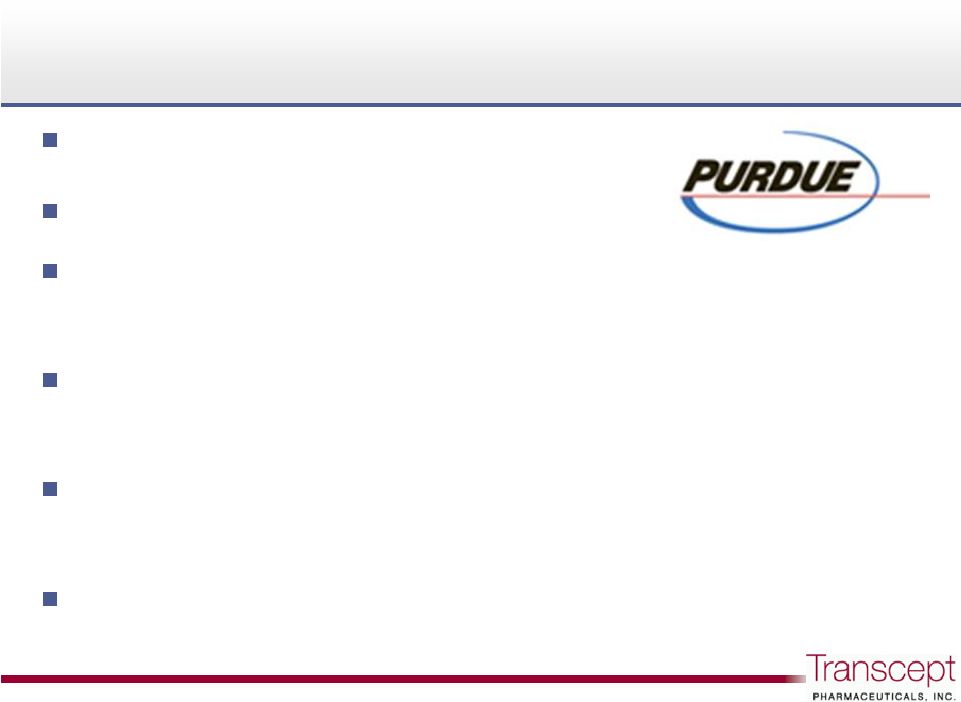 Leading
pain therapeutic franchise 2010 net revenue: ~$2.4 billion
Branded products include:
OxyContin
®
, MSContin
®
, Dilaudid
®
, Butrans
®
Sales force of >500 field reps calling on primary care
physicians and high prescribing specialists
High value pain prescribers tend to be significant insomnia
prescribers
Multi-year sales and marketing agreement with psychiatry
co-promote option, royalties and milestone payments
Commercialization partnership with Purdue Pharma
Commercialization partnership with Purdue Pharma
11 |
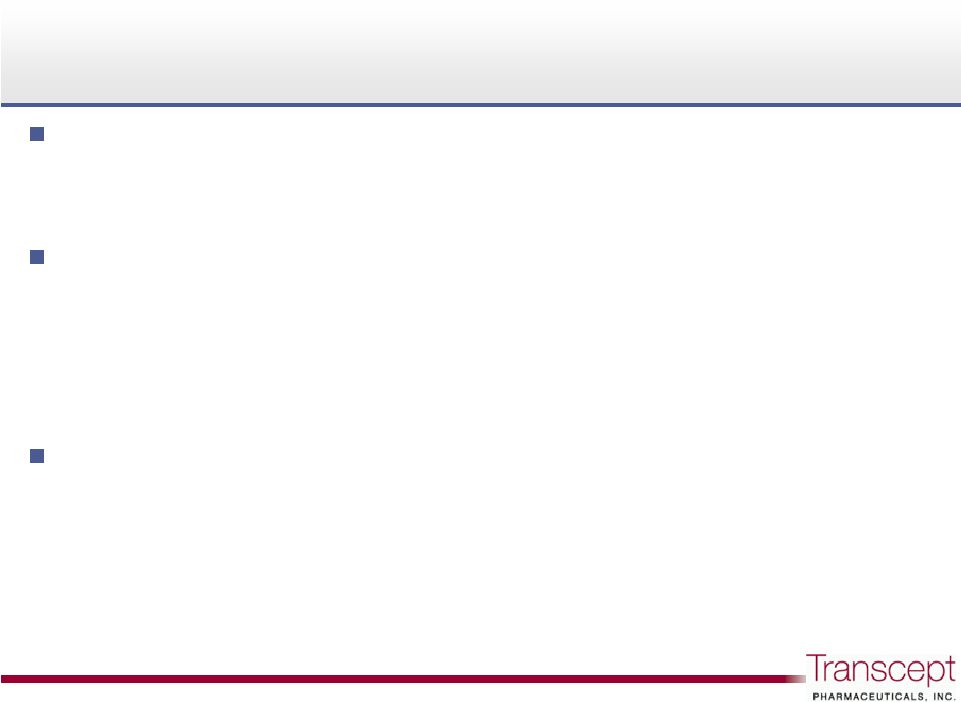 Commercialization agreement: key Transcept benefits
Commercialization agreement: key Transcept benefits
Co-promote option: foundation for a commercial future
–
Transcept option: co-promote to psychiatrists as early as the first
anniversary after Purdue launch
Milestone payments
–
Upfront license fee: $25M received August 2009
–
Up to $90M additional upon the achievement of certain patent
milestones and net sales targets, including $10M for first formulation
patent listed in Orange Book
Royalty structure
–
Base royalty: mid-teens up to mid 20% level on net sales
–
Co-promote
royalty:
additional
double
digit
royalty
on
psychiatrist
Rx
net sales
12 |
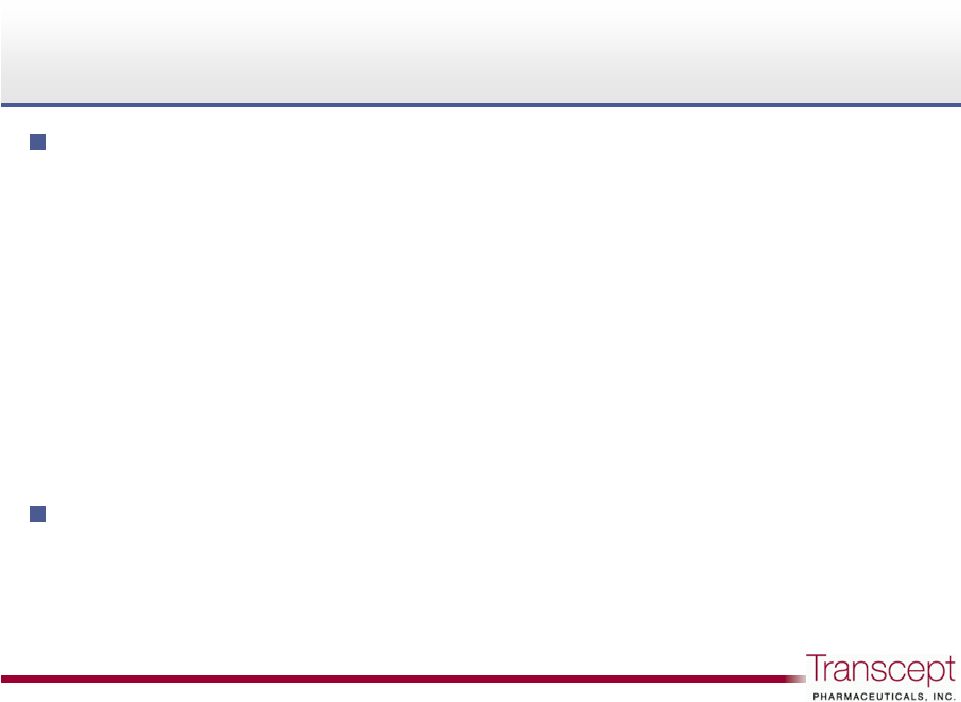 Intermezzo
®
partnership structure enables
significant Transcept marketing efficiency
Intermezzo
®
partnership structure enables
significant Transcept marketing efficiency
Purdue responsibilities
–
U.S. product launch
–
Primary care sales and marketing activities
–
Managed care and formulary placement
–
Manufacturing and distribution
–
Post marketing studies, if required
–
Book revenues
Transcept responsibilities
–
U.S. product approval
–
Psychiatry co promote option 1 yr after commercial launch
13 |
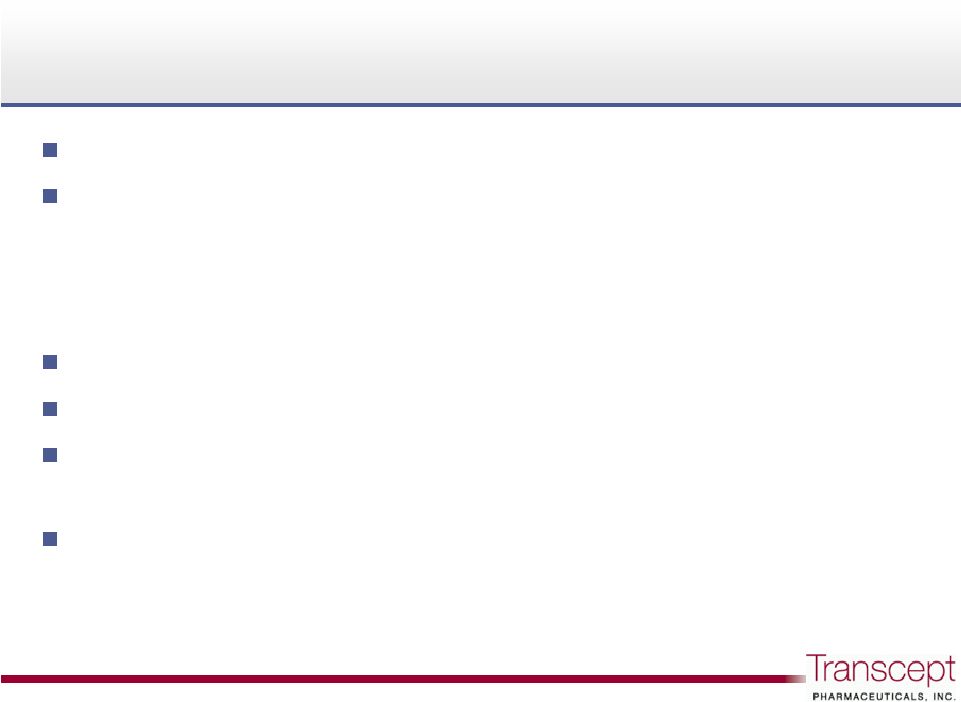 Intermezzo
®
managed markets advisory board with
decision makers covering >170M lives
Intermezzo
®
managed markets advisory board with
decision makers covering >170M lives
Broad formulary access expected
Unmet medical need generally recognized by payers
–
Unique insomnia indication
–
Low dose used less often
–
Delivery technology drives rapid bioavailability
Tier 3 formulary placement anticipated by most plans
Utilization management criteria consistent with other brands
Intermezzo
®
brand parity pricing not viewed as a major
barrier with managed markets
Proven Purdue managed markets team to drive
formulary access
14 |
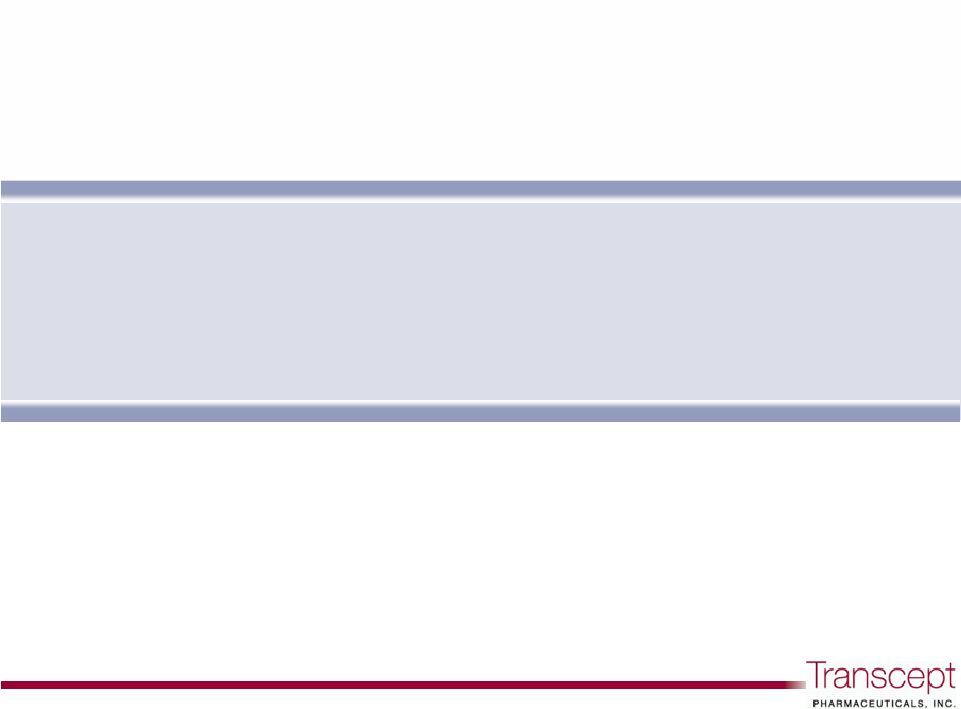 Intermezzo
®
NDA resubmission
Intermezzo
®
NDA resubmission |
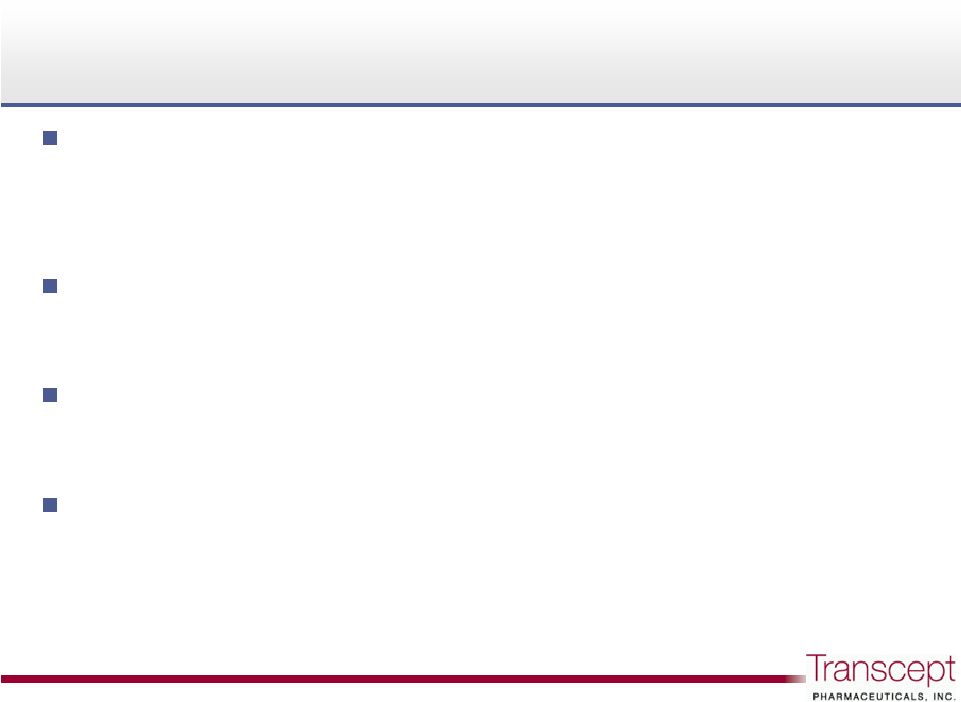 July 2011
FDA Complete Response Letter July 2011 FDA Complete Response Letter
January 2011 NDA resubmission: driving study including
comparative analysis, epidemiology study assessing current
MOTN use of bedtime hypnotics, and packaging changes
FDA newly expressed concern that patients with high outlier
zolpidem blood levels may be at risk of next day impairment
FDA further hypothesized that such patients may belong to
distinct and identifiable demographic groups
FDA recommendations
–
Investigate whether demographic factors contribute to elevated blood
levels
–
Consider modifications in dose, time of dose and patient selection
16 |
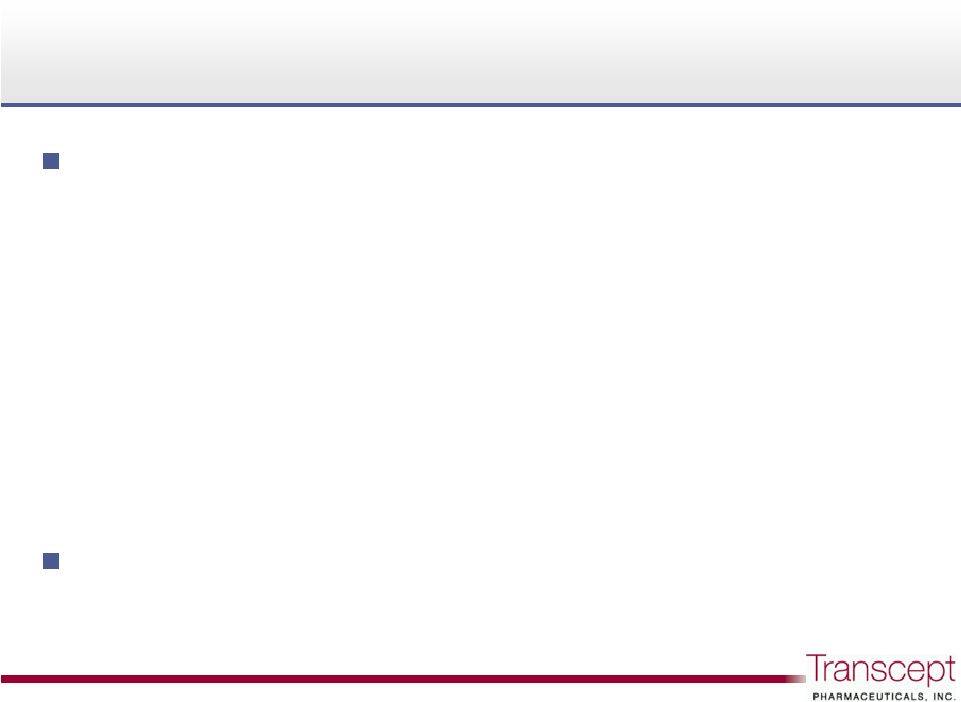 Sept 14,
2011 End of Review meeting with FDA Sept 14, 2011 End of Review meeting with FDA
FDA generally agreed:
–
Change
Intermezzo
®
dose
for
women
from
3.5
mg
to
1.75
mg;
3.5
mg dose for men unchanged
–
Intermezzo
®
should
only
be
taken
if
the
patient
has
4
hours
of
bedtime remaining. Patients should refrain from driving for at least
1 hour after arising and until not less than 5 hours post dose.
–
If
the
planned
resubmission
is
“adequately
concise”
in
summarizing
morning zolpidem levels and evidence that the levels are safe given
the proposed labeling, FDA may be able to consider this
resubmission as a two-month, Class 1 review.
No additional clinical studies are planned prior to
NDA resubmission
17 |
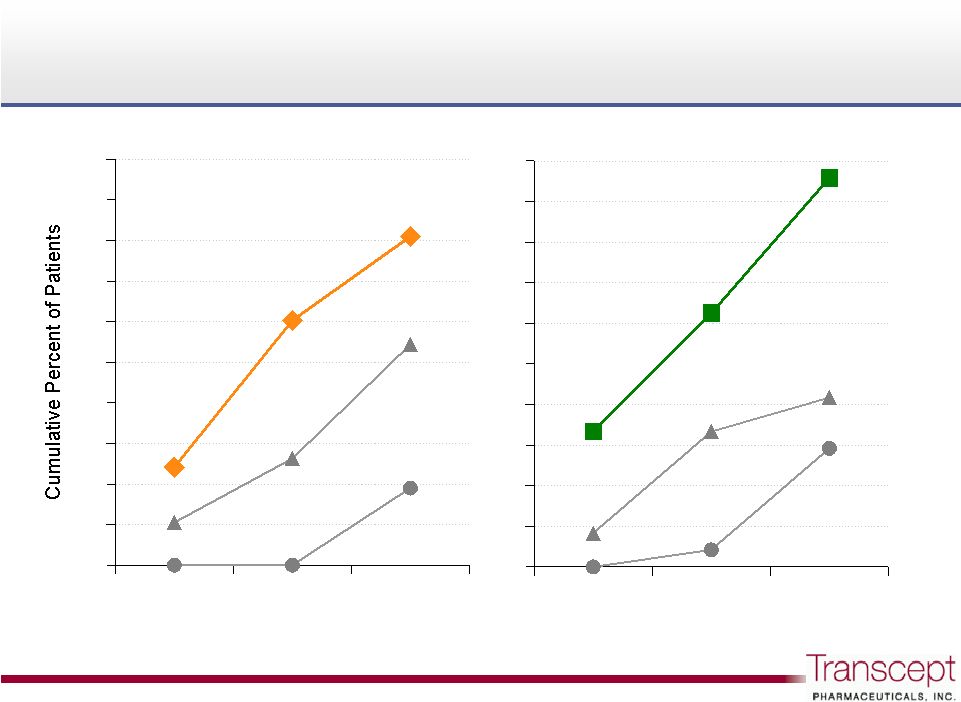 Sleep lab
study: 1.75 mg efficacy in women similar to 3.5 mg efficacy in men
Sleep lab study: 1.75 mg efficacy in women similar
to 3.5 mg efficacy in men
18
<10
<20
<30
0
10
20
30
40
50
60
70
80
90
100
Latency to persistent sleep (min)
<10
<20
<30
0
10
20
30
40
50
60
70
80
90
100
Latency to persistent sleep (min)
Women 1.75 mg (n=58)
Men 3.5 mg (n=24)
60%
63%
Intermezzo®
3.5 mg
Placebo
Baseline
Intermezzo®
1.75 mg
Placebo
Baseline |
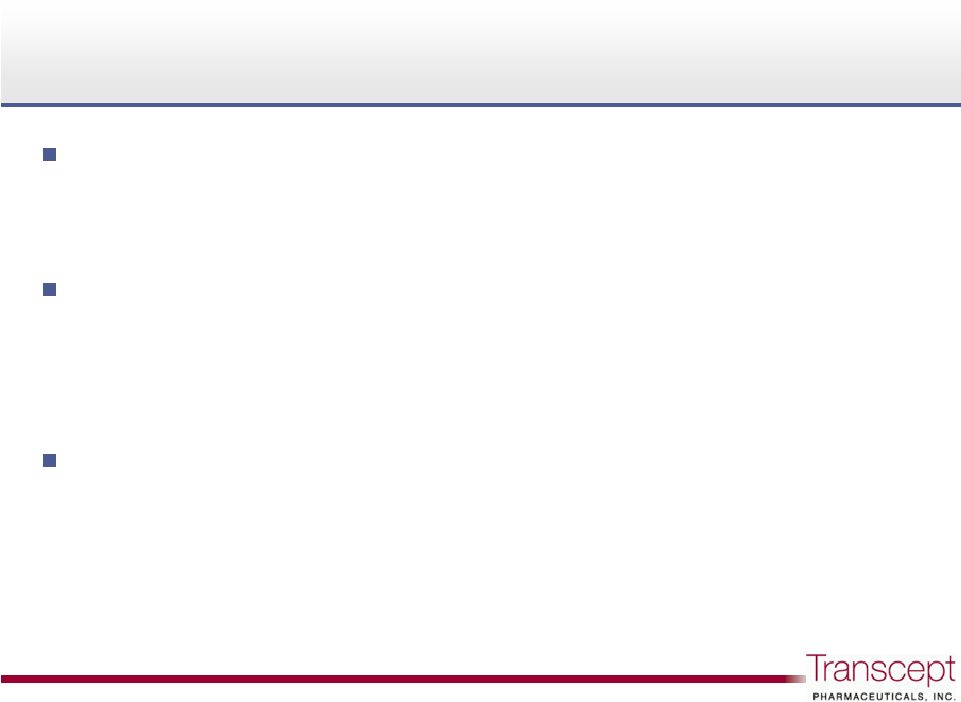 New
Intermezzo ®
instructions are consistent with
current patient behavior
New Intermezzo
®
instructions are consistent with
current patient behavior
Originally
proposed
instructions:
“Intermezzo
®
should
only
be
taken if the patient has 4 hours of bedtime remaining before
being active again”
Newly
proposed
instructions:
“Intermezzo
®
should
only
be
taken
if the patient has 4 hours of bedtime remaining. Patients should
refrain
from
driving
for
at
least
1
hour
after
arising
and
until
not
less than 5 hours post dose.”
The typical American: time between arising and commuting to
work
–
1 hour 53 minutes (mean), National Sleep Foundation 2008
–
1 hour (median), Bureau of Labor Statistics 2003-2010
19 |
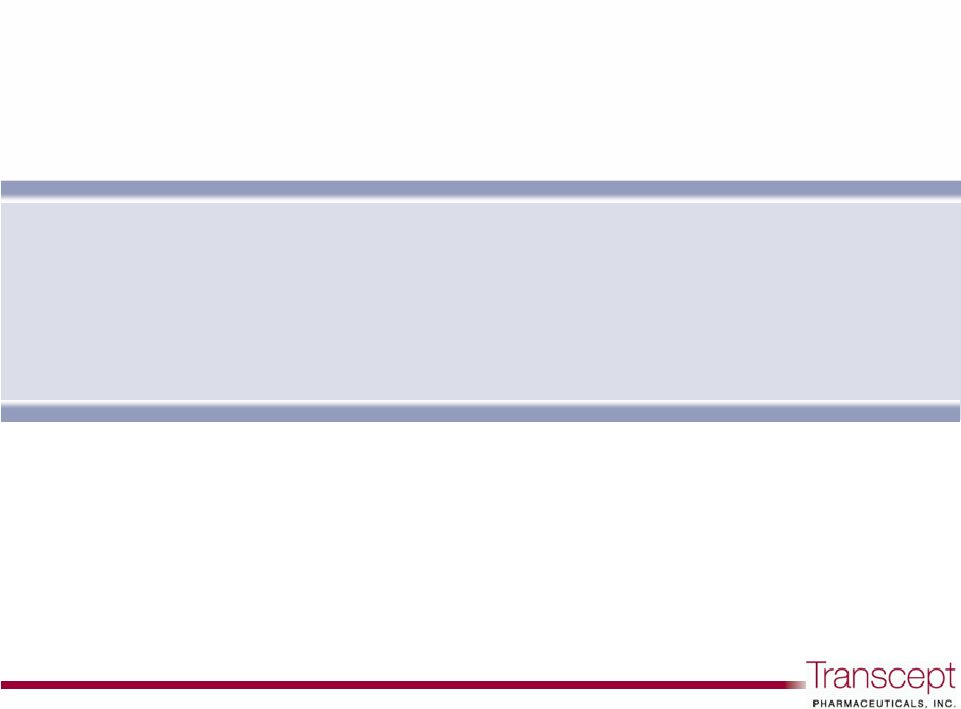 Intermezzo
®
:
intellectual property
Intermezzo
®
:
intellectual property |
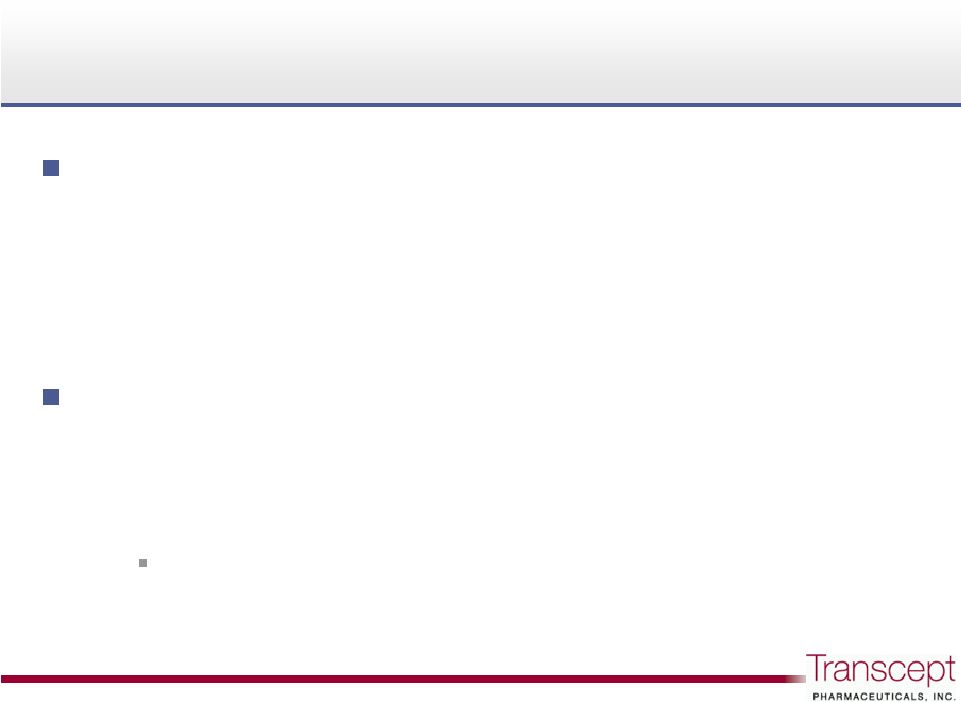 Intermezzo
®
: two formulation patents issued; method
of use patents pending
Intermezzo
®
: two formulation patents issued; method
of use patents pending
Formulation for transmucosal absorption
–
Two
issued
U.S.
patents
-
7,682,628
and
7,658,945
–
Patents expire no sooner than February 2025
–
Low
dose
zolpidem,
~1mg
to
~5mg
–
Formulation with buffer system for transmucosal absorption
Method of treating MOTN awakenings
–
Priority date: May 2006
–
Low
dose
zolpidem,
~1mg
to
~4.75mg
–
Treatment of middle of the night awakenings
Administration as needed after the subject awakens
–
Proposed claims cover multiple dosage forms
21 |
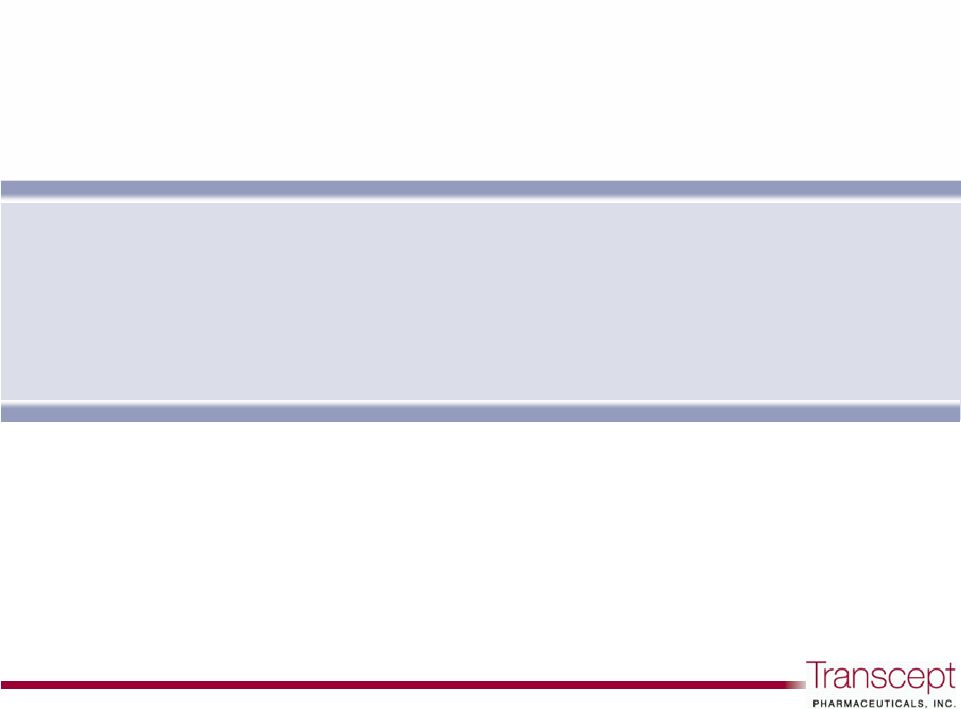 TO-2061
(low dose ondansetron)
TO-2061
(low dose ondansetron)
22
Proposed indication: adjunctive therapy in adult patients
with obsessive compulsive disorder (OCD) not adequately
responsive to currently approved OCD medication |
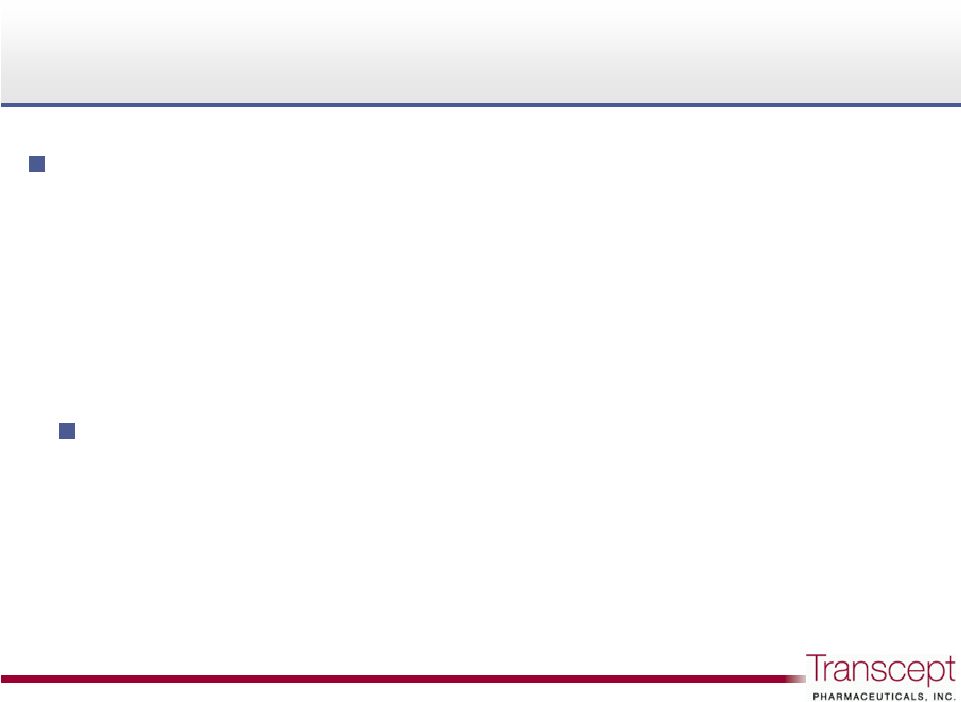 Significant
unmet medical need: OCD patients not responding adequately to approved
medication Significant unmet medical need: OCD patients not
responding adequately to approved medication
Obsessive Compulsive Disorder
–
Intrusive thoughts and repetitive actions to reduce distress
–
Affects 1% to 2% of U.S. adult population, 40% to 50% seek treatment
–
Significantly impacts everyday life activities of patients and their families
–
40% to 60% of OCD patients do not respond adequately to approved
medications,
which
include
the
SSRIs
Prozac
®
,
Luvox
®
,
Paxil
®
,
Zoloft
®
No FDA approved medication for treatment resistant
OCD
–
Atypical antipsychotics are often used off-label to augment approved
medications
•
~68% of treatment resistant OCD patients do not respond
•
Frequently reported adverse events: weight gain, metabolic disorder
23 |
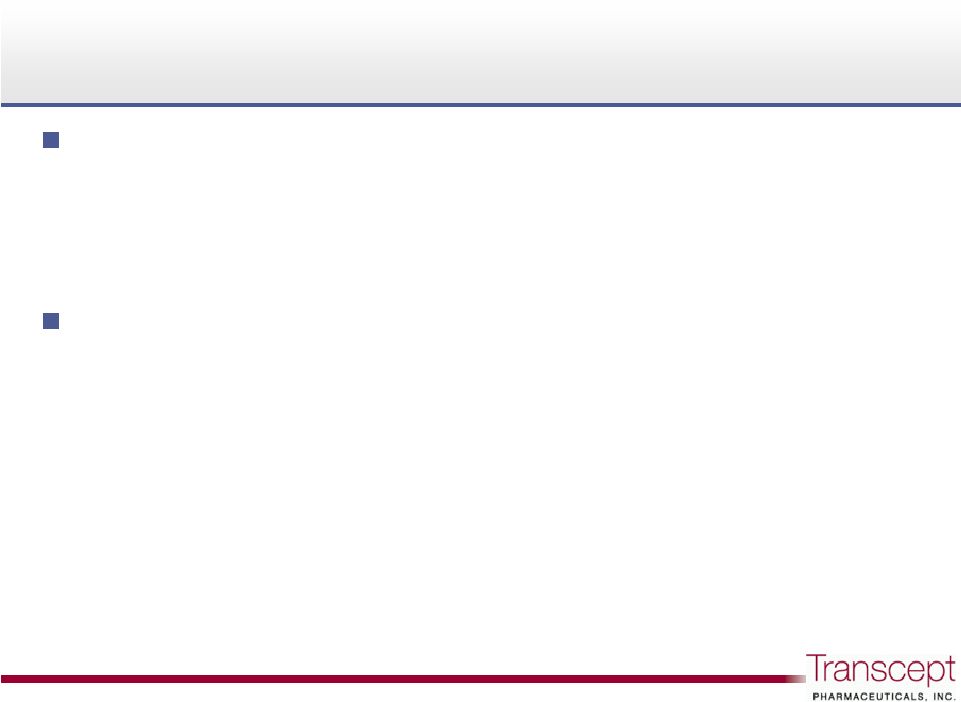 Pilot
studies: ultra low dose adjunctive ondansetron therapy in SSRI resistant OCD
Pilot studies: ultra low dose adjunctive ondansetron
therapy in SSRI resistant OCD
Ondansetron
(5-HT
3
antagonist
approved
as
Zofran
®
)
–
Affects serotonin and dopamine pathways
–
Typical
daily
Zofran
®
doses
of
16
mg
to
24
mg
for
nausea
and
vomiting induced by chemotherapy, radiation therapy and surgery
Two 12 week open-label adjunctive therapy studies
with ondansetron titrated to 0.5 mg BID dose
–
Pilot
Study
A
(1)
:
Adjunctive
ondansetron
therapy
in
patients
who
responded poorly to at least 12 weeks of SSRIs combined with an
atypical antipsychotic, n=14
–
Pilot
Study
B
(2)
:
Adjunctive
ondansetron
therapy
in
patients
who
responded poorly to at least 12 weeks of SSRI treatment, n=21
24
(1) S. Pallanti, S. Bernardi, S. Antonini, N. Singh, E. Hollander: Ondansetron augmentation
in Treatment-Resistant Obsessive-Compulsive Disorder, CNS Drugs (2009); (2)
S. Pallanti, S. Bernardi, E. Hollander: Ondansetron augmentation in Treatment-Resistant OCD (TR-OCD):
Relapse in Y-BOCS symptoms following discontinuation of ondansetron, Poster
presentation, American College of Neuropsychopharmacology 49 Annual Conference, December 2010.
th |
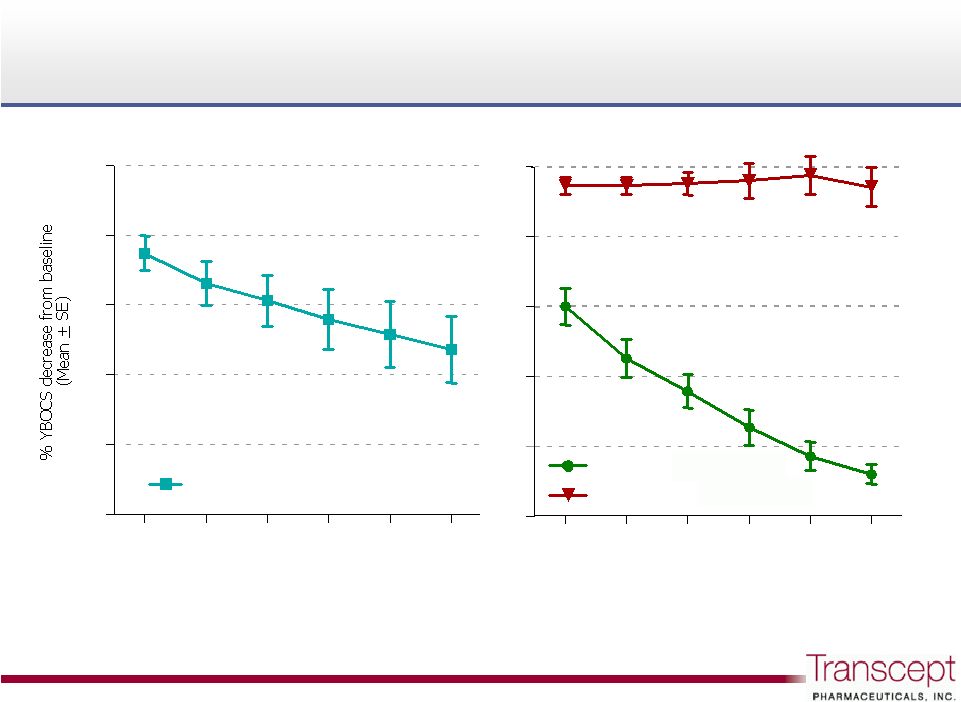 Improvement:
measured as a % decrease over baseline on the Yale Brown Obsessive Compulsive Scale
(YBOCS) Improvement: measured as a % decrease over baseline on the
Yale Brown Obsessive Compulsive Scale (YBOCS)
25
All Patients: n=21
26.3% improvement at 12 weeks
Responders: n=12 of 21 (57%)
44.3% improvement at 12 weeks
Pilot Study B, n=21
Week
2
Week
4
Week
6
Week
8
Week
10
Week
12
50%
40%
30%
20%
10%
0%
All patients
Week
2
Week
4
Week
6
Week
8
Week
10
Week
12
50%
40%
30%
20%
10%
0%
Responders
Non-responders |
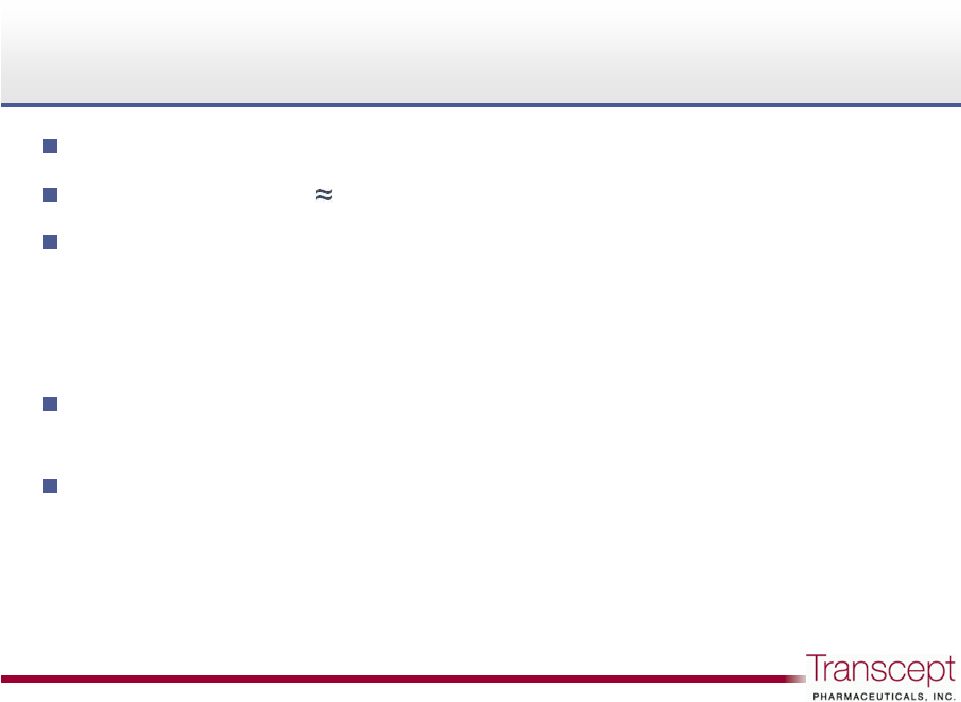 505b2 NDA
pathway Phase
2
study,
n
150,
top
line
data
est.
late
2012
Intellectual property
–
Method of use patent application filed, priority date May 19, 2009
–
Ondansetron, up to ~1.5 mg/day
–
Pending claims for treating SSRI resistant OCD with ondansetron augmentation
Strategic fit: psychiatry
–
~87% of patient visits for OCD were to psychiatrists in 2009
*
–
Complementary
to
Intermezzo
®
psychiatry
co-promote
option
with
Purdue
26
* SDI Physician Drug and Diagnosis Audit
TO-2061
development
overview
:
Managed care survey (~108M lives): unmet medical need
acknowledged, Tier 3 formulary placement expected |
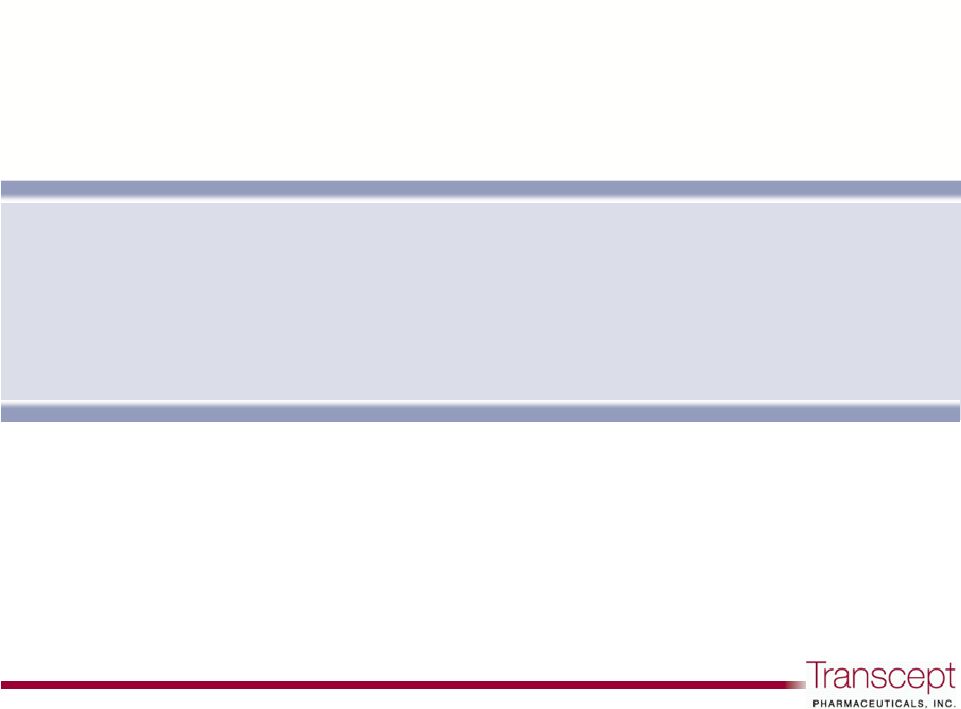 Financial
overview Financial overview |
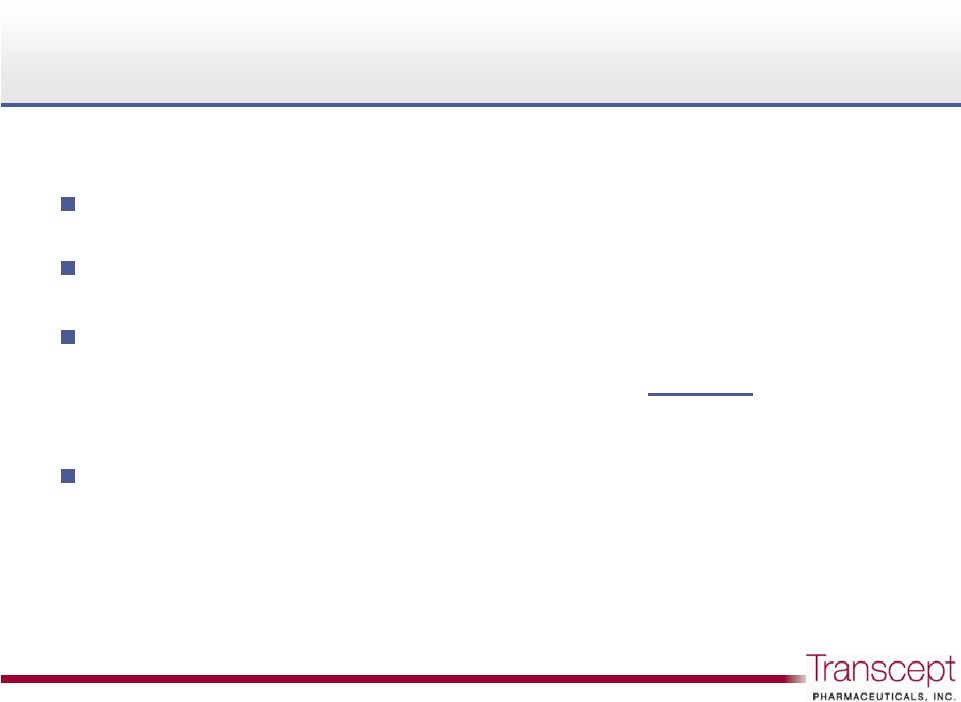 Financial
position Financial position
Cash & investments (6/30/11):
$59.6 M
Q2 2011 cash burn rate:
$ 1.2 M / month
Shares outstanding (9/15/11):
13.5 M
Options / warrants / other:
3.5
Total:
17.0 M
Employees (9/15/11):
18
28 |
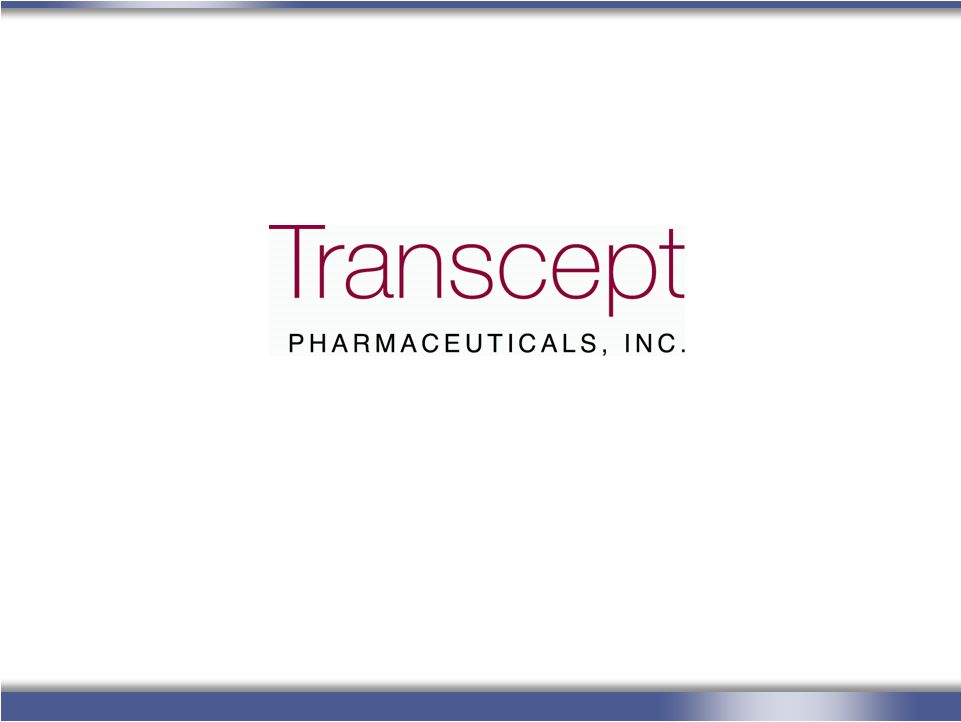 Intermezzo
®
is a registered trademark of Transcept Pharmaceuticals, Inc.
Ambien
®
and
Ambien
CR
®
are
registered
trademarks
of
sanofi-aventis
Lunesta
®
is a registered trademark of Sunovion Pharmaceuticals Inc.
Zofran
®
and
Paxil
®
are
registered
trademarks
of
The
GlaxoSmithKline
Group
of
Companies
Prozac
®
is a registered trademark of Eli Lilly & Co.
Luvox
®
is a registered trademark of Solvay Pharmaceuticals, Inc.
Zoloft
®
is a registered trademark of Pfizer Inc. |
